
Killer Whales
Perhaps the most powerful and spectacular predator on earth, Killer whales are
found in all the world’s oceans and have no natural enemies.
Large adults weigh up to 10 tons and are capable of speeds of 35mph... fast
enough to barefoot waterski behind!
Killers are members of Delphinidae and are really the largest of the dolphin
family.
With their size, speed, power and organisation, they can take on virtually any
creature in the sea, from the mightiest Blue whale, to great white sharks,
rays, seals, squid, sea birds, penguins, turtles or even tiny herring.
Orcas have brains between 4 to 6 times the size of a human brain and have
astonishing sonar capabilities. The sonar works effectively as an acoustic form
of x-ray vision. The strongest sonar echoes come from items such as air
cavities and skeletal systems, allowing orcas to acoustically “see” inside the bodies of other living organisms.
Zoologist Dr John Ford of Vancouver aquarium reports Orcas enjoy looking at
books, particularly ones which contain pictures of killer whales. They will
study the pictures through the window of the aquarium and then whistle when
they wish the page turned.
Killer whales can grow to around 30ft in length, with females being usually
smaller than males. Old Tom, a male was 22ft long, shorter than female orcas in
some parts of the world.
Both males and females have striking black and white markings. These seem to
have the function of distractive camouflage, making a fleeing prey aware it is
being chased, but unsure which way the orca is heading. The markings make the
outline and orientation of the orca unclear and the best escape route
uncertain. There may also be an element of sexual selection in the evolution of
orca markings and other body features.
Orcas are one of the few animal species to have distinct cultures. Hunting strategies of one orca community are usually unique to that community.
Their cultural behaviours are learned behaviours and not instinctive behaviour.
When an individual innovates a new behaviour, others will copy and youngsters
will be taught by adults. In the case of the seal hunting orcas of Argentina,
orcas practice beaching and rescuing themselves, and pass the skills on to
their offspring in preparation for catching seal pups on the beaches of seal
colonies.
Orcas are also one of the few species such as bottlenose dolphins that are known
to be self aware, and able to recognise themselves in mirrors. They are also conscious
breathers, meaning that they cannot be given a general anaesthetic. They must
consciously think to breathe in and out, unlike in humans where we usually
breathe without consciously thinking about it.
Male Orcas have tall distinctive dorsal fins often around 6ft high. The
differences between dorsal fins and body markings allow different individuals
to be distinguished by experienced observers. This principle was first
identified by the Eden whalers who with their years of daily observation came
to recognise different killers by sight.
Most of the Eden killers were given names although the names of only around 20
killers have been documented.
The indiginous Yuin people of the region called the Killers “Beowas”, meaning brothers or kin.
They believed that the killers were the embodiment of the returned spirits of
their ancestors. When a valued member of the tribe passed away, he would “jump up” and return in killer whale form.
The killers were treasured as sacred members of the tribe and it was believed
that they would help to provide food for the tribe and protect tribal members
in the water.
To the Davidsons, the killers were also family. In 1902 George Davidson
petitioned the N.S.W. government to have the killers classified as a protected
species.
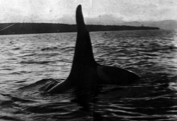
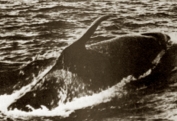
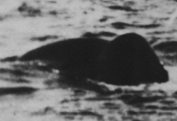
Old Tom
Hookey
Humpy
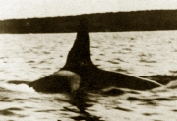
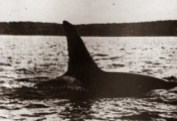
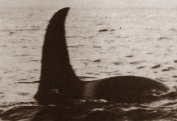
Cooper
Jackson
Typee
Names
Named killers known to date:
Old Tom, Hookey, Humpy, Jackson, Cooper, Charlie, Typee, Stranger, Kinscher,
Montague, Old Ben, Young Ben, Sharkey, Jimmy, Jimmy Albert, Brierley,
Youngster, Walker, Skinner, Big Jack, Little Jack
Co-ordination
In the early years of Eden whaling in the 1840s there were reportedly around 50
killers spread through 3 main pods. All three pods cooperated together. One pod
stationed far out to sea would drive whales in towards the coast, another pod
would attack the whale and another pod would be stationed ahead of the whale in
case it broke loose.
The killers would surround the whales to cut off any escape route, some swimming
under the head to prevent it diving and others would throw themselves on top of
the blowhole to prevent it breathing.
In the Davidson period, a smaller pod of 2 or 3 individuals would leave the main
action and swim to the mouth of the Kiah river deep within twofold bay and
alert the whalers by floptailing at the river mouth, then lead the rowboats out
to sea.
This behaviour was recorded on movie film by C.E.Wellings in 1910.
If the killers had somehow missed a whale that the humans had spotted, the
Davidsons would hit the water surface with their oars to alert the killers.

Jackson and Minke at north end of Aslings Beach. 1900
Photo by Vogt from Mary Mitchel’s collection.
The story of Jackson/Typee had appeared only in oral history and written
accounts for 98 years untill the Author discovered this image in Mary’s collection in 1998.
Again photographs support the accuracy of the oral history.
A killer’s “murder”
In 1900 the killer pack numbered about 15 to 20 orcas. That year a killer known as Jackson beached himself on Aslings
beach whilst chasing a minke whale. A vagrant named Harry Silkes knifed both
whales to death before the Davidsons could intervene and Silkes had to be
escorted out of town by police. Immediately afterwards the rest of the killer
pack left Twofold bay for the rest of the season. The following year, the
killers’ number had dropped from around 15 to 6 and many of the yuin tribe left Eden and
moved to new areas.
George Davidson began legal action to have the killers protected by law.
The original postcard photographs by Vogt have C.E. Wellings’ handwritten note on the back that the killer is Typee (rather than Jackson).
The sudden disappearance of at least half the killer pack in the space of a year
led to speculation of the orcas disgust with humans due to Jackson/Typee’s killing, and recently Danielle Clode suggested sudden decline due to food
shortage caused by foreign offshore Antarctic whaling.
However George and Archer Davidson spoke with visiting Norwegian whalers around
that time who proudly boasted of indiscriminate shooting of orcas in Australian
waters. The Norwegians were worried that orcas would eat all of a captured
whale and leave nothing to process. This had been known to be false by the Eden
whalers for over half a century. This strongly motivated George to have the
orcas protected by Law in 1902.
The Eden killers eventually dwindled from 6 in 1901 to 3 in the late 1920s and
eventually only Tom who died in September 1930.
Other orcas who were recognisable to the whalers such as Ben and young Ben made
fleeting visits to the Bay after this time and even visited the kiah river
mouth but did not resume cooperation with the whalers who had virtually
abandoned whaling by this point.. This may suggest that a number of the
original Eden pod had moved offshore from 1900 and changed their hunting
stategies . The orcas who now occasionally visit Eden today may be decendants
of this group.









